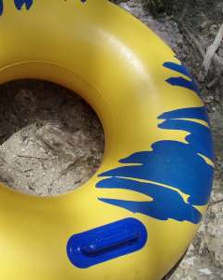Ichetucknee River History
The springs and river were used consistently by early cultures of Native Americans, going back thousands of years. Bones and teeth of mastodon and other extinct mega-fauna have been found in and alongside the river. About one mile downstream from the headspring of the river, a 17th century Spanish mission site has been identified in the park next to a short tributary connecting Fig Springs to the Ichetucknee River. San Martin de Timucua, built in 1608, was one of the major interior missions serving the important Spanish settlement of St. Augustine and flourished through most of that century. The Seminole Wars of the early to mid-1800s drove those natives from north Florida. In the late 1800s, William Henry Collins owned the Mill Pond store and Gristmill on the Ichetucknee to grind corn into cornmeal and grits for the booming population of nearby Fort White, Florida. For a short while Ichetucknee even had a post office at the Mill Pond store. With the gradual decline of Fort White between 1895 and the first World War, the population of Fort White plunged from two thousand to several hundred, resulting in the closure of the mill and store. The locals have always known of and enjoyed the Ichetucknee River and Springs. It is the perfect place to cool off at the end of a long, hot day in the fields. However, before 1970, the existence and location of this natural wonder were something of a secret, known only to local residents. The road to the spring was not paved, nor was it marked. The spring was on private property and the owners mostly ignored it. During the late 1960s, the area was overrun with students from the nearby University of Florida. Food wrappers and drink containers littered the area because there were no trash receptacles and no garbage pickup. Broken glass was occasionally found on the rocks and in the water. After a swimmer was injured, the absentee property owners threatened to fence the area and curtail public access. The owner looked for an opportunity to find an ecologically minded buyer. The State of Florida purchased the property from the Loncala Phosphate Corporation in 1970 for $1,850,000 and a much needed cleanup took place. The springs became a state park, and Columbia County built a paved road, number 238, for easier access. In 1972, the head spring of the river was declared a National Natural Landmark by the U. S. Department of the Interior. Now everybody knew about Ichetucknee. The main tributary flowing from Ichetucknee Springs soon became the most popular tubing river in the world, attracting over five thousand people daily during the peak summer months. Hundreds of others came to swim and picnic at the headspring, scuba dive in the caves of the famous blue hole, and walk the nature trails that wind through the park's hammocks and longleaf pine forests. Not surprisingly, it wasn't long before Ichetucknee Springs began showing the obvious signs of over-use. Underwater plants were uprooted, wildlife disappeared, and bank erosion increased. To rectify these problems, the Park Service implemented a "carrying capacity", limiting the number of people on the river at any one time. The effect on the spring ecosystem was both positive and immediate. Vegetation began to reappear, wildlife returned, and the turbidity disappeared. To curb littering, the Park Service prohibited food, drinks, and tobacco on the river, which has helped return the area to its natural, pristine beauty. | ||
Copyright SK Creations, Inc. 1999 - 2014. Not
affiliated with or endorsed by any government agencies.
|

